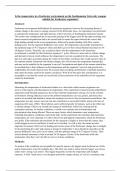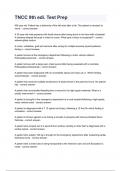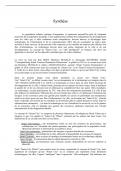Is the temperature in a freshwater environment on the Southampton University campus
suitable for freshwater organisms?
Abstract:
Freshwater environments hold habitats for numerous organisms, however the increasing threat of
climate change to the areas is causing concern for the freshwater areas. An experiment was performed
to calculate the temperature and light intensity of the University of Southampton freshwater stream.
The results were complicated due to inaccurate placing of the loggers used for the data recording, and
hence research and prediction had to be carried forth to ensure the report showed the correct data.
High shading should be the lowest temperature, followed by partial shading, little flow, and no
shading areas. For the organism Bullhead Cottus gobio, the temperature successfully maintained in
the optimum range of 4-27 degrees Celsius and didn’t go over their critical thermal maximum of 24-
28 degrees Celsius. Therefore, the conclusion shows that the temperature in the freshwater
environment is suitable for the freshwater organism C. gobio. However, areas such as climate change
and alternative factors which influence the temperature were not considered in this conclusion. The
data was only taken in autumn during the weeks of November, and hence this would increase when in
the summer months. Partnered with climate change, this will increase the temperature dramatically
and may not be suitable for the organism’s survival. Precipitation and depth of the streams should also
be recorded due to their influence on the temperature and the organism’s survival and growth rates.
Additionally, the results did not show the accurate data recordings and therefore could hold anomalies
and cannot be purely used for the reports conclusion. With all of this taken into consideration, it is
acceptable to say that the results are invalid and a final conclusion of the suitability for the organisms
cannot be determined.
Introduction:
Measuring the temperature of freshwater habitats is a vital action which ensures organisms can
survive in the region with fluctuations in temperatures. This experiment is based towards poikilotherm
organisms (cold-blooded organisms), due to their internal temperatures relying a lot on the external
environment. Strong influences such as the ambient temperatures can vary greatly, and hence they
need to be recorded and studied to ensure the organism can survive the environment around them. The
temperature not only ensures survival, but also contributes to successful fertility and growth rates of
organisms (D.Cassie, 2006). These habitats can be affected greatly by humans- such as the effect due
to climate change. Effects can include the change of metabolism, behaviour, feeding and the
community structure. In harsher conditions, it could even continue into acclimatization and
physiological state being affected. There are many factors which determine water temperature,
including atmospheric conditions, and stream beds. In this experiment, the minimum and maximum
temperatures are very important as it shows the lowest and highest temperatures which the freshwater
area holds. If the minimum and maximum for the organism is higher or lower than the waters, they
could struggle to survive and hence it needs to be recorded. As well as this, the means are also
important to measure if the level of shading and various areas of the freshwater change due to sunlight
levels penetrating the water and causing a change in temperature. I have decided to specialise on the
species Bullhead Cottus gobio in my report, with the optimum range of 4-27 degrees Celsius. Their
critical thermal maximum is held at around 24-28 degrees Celsius. If the freshwater holds this
temperature, then they won’t be able to survive in those conditions.
Methods:
To analyse if the conditions are acceptable for specific species, the loggers must be placed on a brick
and be immersed in water for multiple days. The brick was used to ensure that the logger was always
under water- acting as an anchor. This logger frequently records the temperature and sunlight
exposure. A brief visual survey was designed around the campus stream, as well as a schematic map
, of the stream showing the location of the loggers. Notable features and points of reference were
shown on this schematic map to ensure individuals could locate the logger’s destination with
accuracy. To add to the annotated map, brief notes were recorded to ensure the practical could be
repeated with our sample, including a photograph of the exact location after the logger had been put
under the water. After 2 weeks of the loggers recording data, they were recovered from the water and
it was downloaded. The loggers were placed in 4 different regions- little or no shading, partial
shading, high level of shading, and a “ponded” area with little or negligible flow. These areas of
riparian shade were decided to ensure our results were varied and shows each area of temperature in
the freshwater regions. They were all taken from the region around the Hansard gallery to the Student
Union Building. Unfortunately, one of the loggers could not be relocated and hence the region around
the Valley gardens cannot be reliably used due to the missing data for high level of shading in that
area. Due to this, the data I have used for my analysis holds one logger per area, instead of 2. This
could increase the chances of error and false data.
Results:
Figure 1






